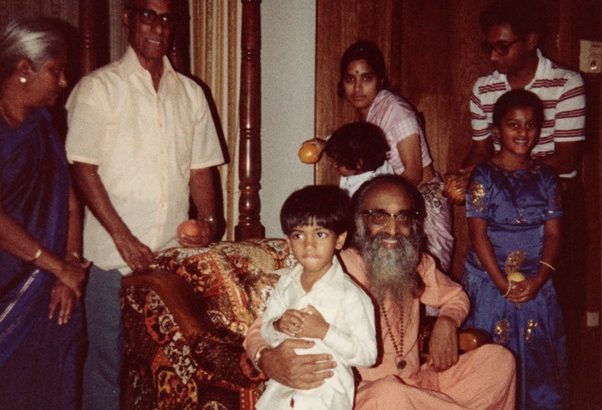[ Sowmya Ayyar is the founder of Prafull Oorja, an NGO which trains yoga therapists to work with a variety of under-resourced communities. The Sangha has touched the lives of 500+ individuals in Bangalore every week since 2013. Sowmya is also a Karnataka Yoga Council Member for Women's International Chamber of Commerce, India (WICCI). In this write up, Sowmya shares her personal journey into Yoga and in the course explores how our family, our upbringing etc. offer us a tremendous opportunity to practice and live yoga.]
Running my NGO, Prafull Oorja, being on the WICCI Karnataka Yoga Council, and supporting Indica Yoga, all give me the opportunity to engage with individuals whose “focus” is in the Yoga Field or Yoga Industry. And if it’s not with a yoga teacher, guru, intern, trainee, or friend, it’s with people eager to know more about yoga. In general, I’m always involved in something “yoga” connected.
A big topic in the field is how to get our families and friends to “do” yoga. Especially when raising children, those of us who have been touched profoundly by yoga, enough to get certified and teach, want to bring our families and friends into the same path.
The moment someone finds out I am a yoga teacher, the first question is, “Do you do a lot of Yoga? Do you practice Yoga?” Inherently, they are asking if I practice asanas to keep a fit body.
Sure, I do. Most days, I either engage in “homework” from Atmadarshan Yoga, the Bangalore Branch of Bihar School of Yoga; or my exercises from Yogoda Satsanga Society, the Indian arm of Paramahansa Yogananda’s Self-Realisation Fellowship based in Encinitas, California. Or I might opt for attending an online class of Hormone or Yin Yoga to help with my own emotional and hormonal balancing, or call a friend to jointly practice Trataka to support eye strength. Maybe a friend is leading a session of Surya Namaskar or other practices where I am engaged at the Annamaya and Pranamaya Kosha levels, sometimes also the Manomaya Kosha if I’m doing a Yoga Nidra or mental awareness of my physical and emotional states. I’m really blessed that I can spend this time in my own contemplation, reflection, and growth towards a spiritual goal of Samadhi. However, my yoga practices are more than what you might see on my mat-- which takes a maximum of 45 minutes, even on the days when I really “practice”. (My “seated with eyes closed” meditation practices might be longer.)
Most of us who have done any sort of Yoga Teacher Training have also understood, accepted, and realized through the teachings of Yoga (be it Patanjali’s Yoga Sutras, or Hatha Yoga Pradipika, or even the Srimad Bhagavad Gita). Some of the Yoga Schools we’ve attended have included “Karma Yoga”, focusing on seva, or selfless service. We all hail the First two limbs of the Ashtanga Yoga Path, Yamas and Niyamas, and in our TTCs, we discuss how to bring these characteristics of satya (truth), ahimsa (non-violence), asteya (non-stealing/ appropriation), brahmacharya (restraint and conservation of resources and energies), and aparigraha (non-hoarding), and saucha (purity and cleanliness), santosha (contentment), tapas (discipline), swadhyaya (self study), and Ishwara Pranidhana (surrender and acceptance). We talk about vairagya, abhyasa, and everything else in the Yoga Sutras, Bhagavad Gita, and Hatha Yoga Pradipika.
We go beyond that and recognize the greatness of the Bhakti Movement saints, such as Soordas, Tulsidas, Adi Sankara, Kanakadas, and Meera bai. We bow to them, who devoted their lives to loving their God. We find the beauty of Yoga in connection with Nature, and herald the great environmentalists of various periods, including the modern times. We find passion in making yoga the great equalizer, using it with all social justice topics.
Even as yoga teachers, most of us don’t sit on our mats for hours every day. Rather, we wake up and do our daily activities, and spend some time in meditation, asana, and pranayama practices. Some of it is regular tapas. Even still, we are all human, and our bodies are only as much as they are, though we keep trying to maintain our flexibility and our stability, hopefully in the aim of being able to sit with sthiram and sukham in an asana for dhyanam!
We also need change once in a while, so we mix it up a bit, with perhaps attending an online satsang or video meeting with our fellow teachers and friends; or we choose to take a day off and just relax; or we have to change our timings because it’s a festival day and we want to celebrate (especially in the Covid Times when we don’t want to buy sweets and snacks, and instead choose to make things at home). Sometimes we choose to walk or run, dance or exercise, rather than an asana practice. For us, it’s all part of yoga, as long as we are aware of ourselves, our bodies, minds, spirits, and how each thought and action impacts us and the universe around us.
After that, it’s life as usual for yoga teachers too. We spend some time in developing our class curriculums, some time marketing, and some time teaching. We have our house work, our family time, and our personal time; we might even have a regular paying job. Our earnings go into a great yoga retreat, with any luck, in Mysore or Rishikesh. We get a detoxification from the general world and take the time to go deeper within. For us, this is yoga.
So what are we trying to get our families and friends to “do”? If it’s asana, I’ll agree that many of our family members and friends show a lack of interest, or are even wary. Children (especially teens and young adults) might ask “why?” “Why do I need to do yoga?”
A yogi may be one who is able to sit bare chested on a mountaintop. Still, we all know that we yoga teachers are not that. We are normal human beings, in a field or industry that puts yoga and its knowledge systems first, and all else (teaching qualifications, marketing skills, financial planning and skills) second, sometimes third!
Perhaps we put our jobs first, and find in our jobs, a way to build bridges and unify our team members. We might become peace-keepers and resolve conflicts. We try not to take stress on the job, and when we go home, we take some time for restorative asana and pranayama practices, yoga nidra, or other healing techniques. We might find a way to teach a corporate yoga class to our office mates once a month or even weekly; we might find a way to host a Yoga Day event; we might even find a way to teach or practice asana for a minute here or there throughout the day.
Perhaps we put our families first, and take care of elders, children, spouses, partners, and relatives, ensuring they have things to give them a sense of security, a feeling of empathy, a note of love. We might remind our elderly parents and grandparents to move their bodies, even in lockdown or quarantine. We might urge our children to join us in (early) morning asana practice, at least on weekends.
Perhaps we put our homes first, make sure we keep the house clean (saucha) and neat (without being obsessive-compulsive or having too much tapas).
Whatever we do, we try to be mindful and aware.
And whether we recognize it or not, our families and friends are impacted and deep down in their sub-atomic levels, they love it. They may not take up yoga as a “career” or a “job”. They may not practice on the mat. They may not even preach it to others.
I'll bet our family members are quite great Yogis in their own ways.
Anyone who knows my family or my story, will know that my life has been greatly influenced by (3+) generations of yogic women. My great-grandmothers were devotees of Sri Ramana and even were photographed at His Samadhi, weeping the loss of the Saint who taught us to question “Who am I?” and look within for answers.
They raised my grandmother (and my aunt, to some extent). And it shows, in the way my aunt and grandmother have lived their lives. My aunt, for example, is always ready to help, ever ready to support, ever prepared to be present.
My grandmother moved to Lucknow with my grandfather, and immediately took to visiting and living with Swami Sivananda in Rishikesh during summers or holidays. She was loved like a daughter by the Great Guru of Yoga, and he even awarded her a Music Certificate for her beautiful, bhakti-filled songs.
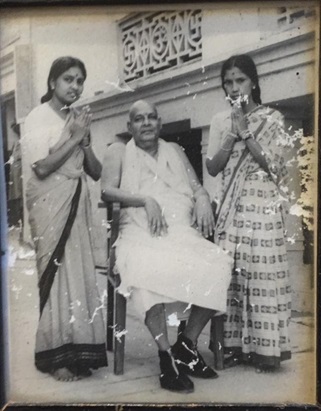
(Swami Sivananda with author’s grandmother, left, and a family friend, right; circa 1960)
Years later, in the US, running from one Guru to the next, in the search of Enlightenment. Eager to pass on such a valuable lifestyle to her children, we often tagged along, and later even went to see our Guru, Ammachi, on our own. I remember vividly sitting on Swami Chinmayananda’s lap as a small child, whilst he was teaching Gita or giving a topical satsang to enlighten the families present. I also remember the numerous opportunities to be in the presence of the Divine Mother, Sri Mata Amritanandamayi Devi, or other Gurus such as Karunamayi Ma, Ganapati Sacchidananda Swami, or Mathioli Sarawsati Amma. While I may not remember exactly what they said on a particular day, I know the love, empathy, and compassion they showered on me has penetrated deep within me, touching all my cells, intercellular spaces, and subatomic particles within. I remember their ability to actively listen to each of our “problems”, especially as teens and young adults, to inspire and motivate us to be better family members towards each other. Thanks to my mother, I had such a beautiful childhood exposure to Yoga, not as asana, but as a way of life, and a samadhi.
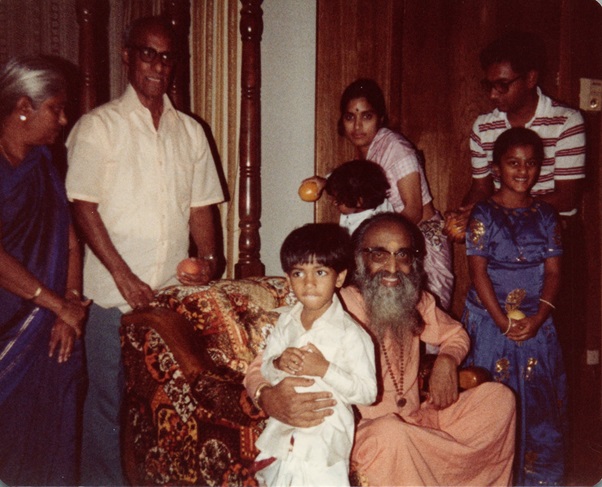
(Author, baby in back, & family with Swami Chinmayananda, circa 1981)
I’ve got a long lineage of strong, inspiring women to look upto while on my journey of living Yoga.
Perhaps, though, the men in my life and lineage are also Yogis. My grandmother used to regale us with stories of her father in Kumbakonam, Tamil Nadu. Natesh Iyer was the Police Superintendent, a position of power and prestige. He could have, like many others, used that in a corrupt manner. Instead, Natesh Iyer chose to stand for Ahimsa: when he found his late wife's sister in an abusive marriage, he helped her to get a divorce (and alimony, in the early 1920s). Another sister in law was asked to sit in a room for her entire life after becoming a widow. He got her out and welcomed her into his humble home to help raise his last two children (my grandmother and her elder sister) and live a full life.
My grandmother later married my grandfather, and found in him a Gandhian (and a yogi?). Ramani was adamant to spin his own cloth and went to Gandhiji's meetings when possible. For him, it was a matter of brahmacharya and the conservation of energy. Ramani practiced Satya: he was the only accountant not to take bribes, even at the expense of not being able to afford his family's needs such as education for his daughters. Ramani also started asana practices including Sirsasana in his 40s and 50s. In his 70s onwards, I remember my grandfather sitting quietly, in self-study (swadhyaya) and self-awareness. He followed a strict schedule, a tapas including mantra japa, pranayama, walking, intake and output, and always, always holding a book of Srimad Bhagavad Gita in his hand. By this time, he had stopped the asana practices completely. Ramani also practiced a number of other alternative therapies such as water and magnet, verily, just an aspect of Yoga-- to unite the various physiological and physical parts of the body to make them prepared for meditation. He slowly started speaking less, in order to conserve more energy in practicing brahmacharya, ultimately for his spiritual development towards samadhi.
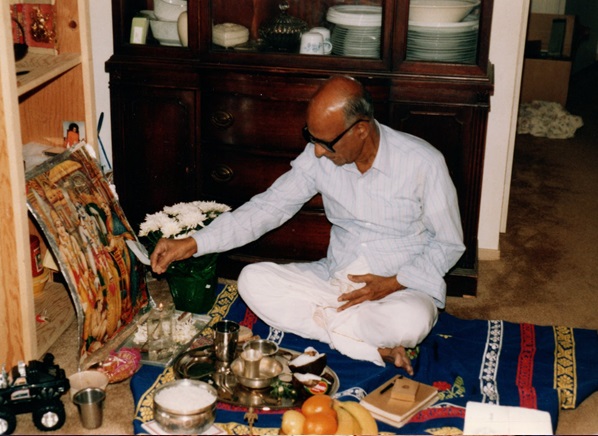
For their "honeymoon" in Hawaii in 2001 (after 56 years of marriage), my grandparents were garlanded by Sivaya Subramuniyaswami, the "Hawaii Swami", to recognize their purity: a sort of saucha, you might say, for they lived with joy and simplicity throughout their lives.
In a more contemporary time, my uncle, Sekar, is a knowledge seeker, a retired professor of Engineering, and perhaps now a teacher of life. A consummate walker, he keeps up his health through daily morning or evening rounds of the neighborhood. Professor Sekar does his own pranayama and japa. With age, his physical flexibility has reduced. His physiological aspects, in the indriyas such as his hearing, are also diminished. He recognizes this, and adjusts the inputs to the body, from small and less meals, to few phone calls.
That is just the body, though. Ever the professor, my uncle is keen to study, study, study, and learn, learn, learn. He wants to inspire others, just as he has always done with his students. Over 80 now, Professor Sekar hopes to form a Sanskrit Study Group, to understand and go deep into the meanings of various Sanskrit texts. Sekar preaches on what Sanskrit means, how it should be used and studied, and also on the Indian education system and guru-sishya relationships. He also has a very staunch method of consumption and conservation (a form of brahmacharya), living with little, and practices his own tapas (disciplines) with a daily routine. He talks of olden times with respect for and union with all living beings and living with less. What can be more yogic?
Only perhaps one person who is staunchly against yoga. My father came from a line of strong Hindu believers, and converted to atheism somewhere along the way. A man of his mind, he lives with little expectations-- just like the Gita instructs us to, again and again (maybe, with the exception that he wants his daughter to learn personal finance and have a steady job). Further, he gives Daana in a most Satwic system, again, just doing his part and leaving the rest to any NGO or individual he supports (EVEN when he supports his daughter or her NGO). My father is an exercise buff and (touch wood) healthy as a horse. While he can do hundreds of push ups, sit ups, jumping jacks, squats, and exercise endlessly, he is against any yoga classes, especially the asana practices.
I don't have children of my own. I just have memories of my godson, Joey Jagadjambu: of teaching him Pranava and Gayathri mantras as the first sounds he heard from my whispering during his days in NICU. A few months ago he started chanting Om, his first utterance. Joey will learn to live simply, without expectations, like his father before him, my best friend and Founding Managing Trustee of my NGO, Prafull Oorja, Kishore Kaushal.
Kishore may not have wanted to be in the yoga world, but the yoga world wanted him. As a young student in Deoghar's St. Francis Xavier, Kishore was nominated to garland Swami Satyananda during the Guru's only visit to a school after coming to Rikhiapeeth for the final stage of his human body. Later, Kishore and I literally ran into each other on the streets of Bangalore. After becoming friends, he and I, along with a few others, founded Prafull Oorja on the idea that Yoga should be available for all the children with Autism and other Special Needs. Even if he wasn't going to do any asana or pranayama practices, they should!
If yoga is asana practice, then my dear loving grandmother is a zero. My grandfather became a zero in his later life. My uncle is a zero. My best friend is a zero. My father is below zero. If yoga is about asana and pranayama, even if I am not perfect in this, how can I ask the same of others? I can only lead by example.
If yoga is about understanding the universe and living in a manner that connects us to all beings and to the Supreme Being, living in harmony with those other beings and with the universe, giving each its due respect and consuming only what is needed for living, then I am happy to say that the members of the male side of my lineage, as well as the female side, are all truly Yogis.
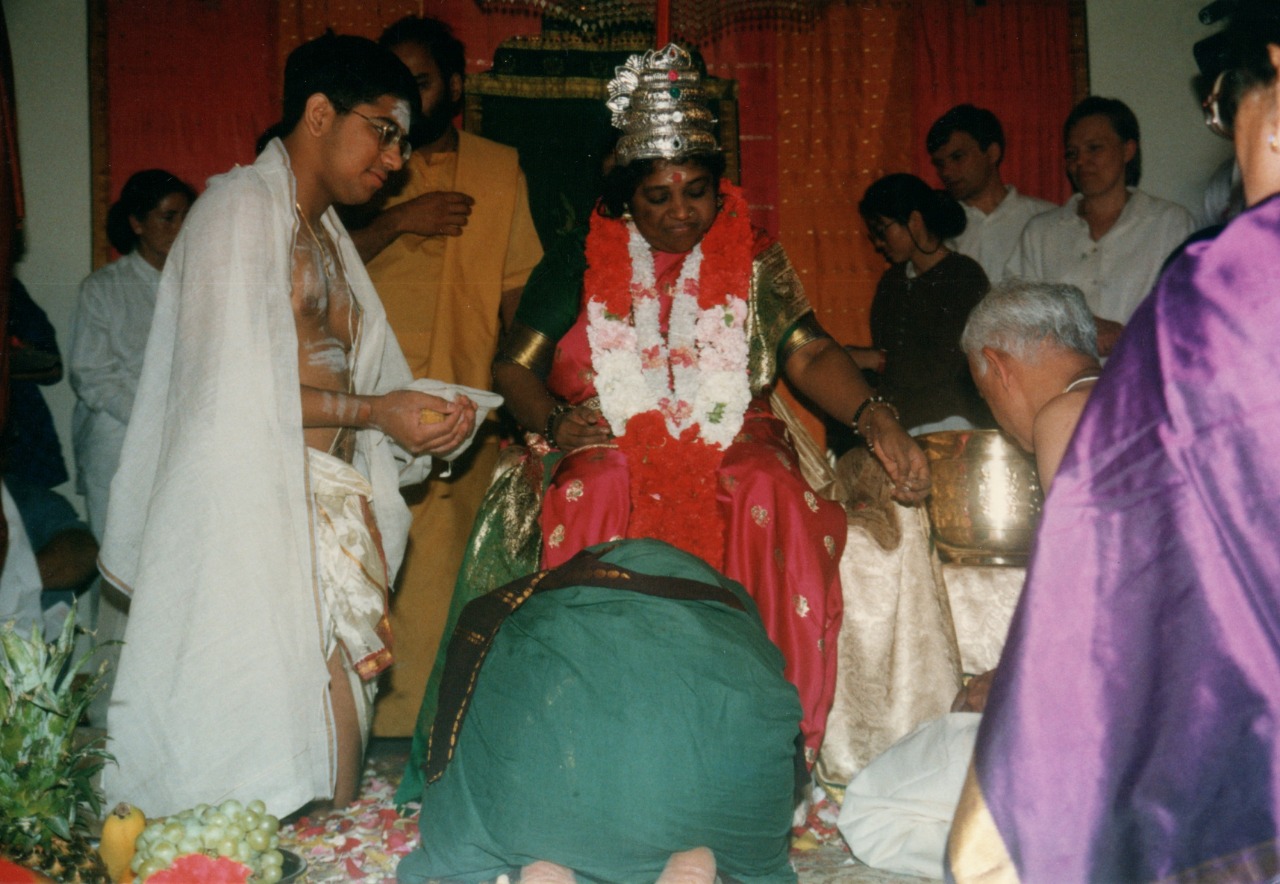
Our families conserve energy and resources, live without expectations, and serve the world in their own ways. We are indebted to them for raising us with yogic values (the yamas and niyamas), just as we will instill the same to the future generations of our family yogis.
Our children, parents, and partners may not practice asana as regularly as we do (remembering that we all take off Sundays, and some holidays). I'm sure that they practice yoga in their own ways, and that they ensure their bodies are fit to meditate, again in their own ways (perhaps through knitting, cooking, or carpentry and woodworking; or as children, through being present when their friends and siblings need them, through slowly studying the world and themselves, understanding more and more, and of course, through focusing on their studies).
Our families and friends are the ones who have shaped us and helped us to join the path of yoga, because they too, are on their own path to their own self-realization. Through the experiences with them, they shape our minds and goals, help us on our paths, just as we help them. Because of them, we are living yoga, and because of us, they are living yoga.

